
Ultramercial, Inc. v. Hulu, LLC - Another Data Point in the Subject-Matter Eligibility of Software Inventions
Why It's Important
The Ultramercial decision will provide an additional tool in invalidating overly broad software-based patents. It also underscores the value of carefully crafting software patents, as those patents are more likely to be found patent-eligible for being directed to something other, or more than, an abstract idea.
Case Summary
Today, the U.S. Court of Appeals for the Federal Circuit affirmed the district court’s grant of WildTangent’s 12(b)(6) motion to dismiss because Ultramercial’s patent did not claim patent-eligible subject matter under 35 U.S.C. § 101.
The case was twice appealed to the Supreme Court, and most recently was vacated and remanded to the Federal Circuit for reconsideration under the Supreme Court’s decision in Alice Corp. v. CLS Bank Int’l, 573 U.S. ____ (2014). On remand from the Supreme Court, the Federal Circuit held that the patent claimed patent-ineligible subject matter based on the two-part test for determining patent subject matter eligibility set forth by the Supreme Court in Mayo Collaborative Svcs. v. Prometheus Labs., 566 U.S. ___ (2012) and Alice, namely, whether the claims are directed to an abstract idea (part 1), and if so, whether the claims contain an element or combination of elements sufficient to ensure that the patent amounts to significantly more than a patent upon the abstract idea itself (part 2).
Applying the two part Mayo/Alice test, the Federal Circuit held that the claims were directed to the abstract idea of showing an advertisement before delivering free content, and that the claims were “devoid of a concrete or tangible application.” The Court recognized that while the claim contained additional limitations that added some degree of particularity, they were insufficient to transform the abstract idea into patent-eligible subject matter. Specifically, the Federal Circuit explained: “We do not agree … that the addition of merely novel or non-routine components to the claimed idea necessarily turns an abstraction into something concrete.”
With respect to the second part of the Mayo/Alice test, the Federal Circuit held that the remaining steps beyond the abstract idea constituted “conventional steps, specified at a high level of generality” and added “nothing of practical significance to the underlying abstract idea.” These steps were therefore insufficient to transform the abstract idea into patent-eligible subject matter.
Although the Federal Circuit found that the Ultramercial claims were directed to an abstract idea, the Court specifically stated that “we do not purport to state that all claims in all software-based patents will necessarily be directed to an abstract idea. Future cases may turn out differently.”
Circuit Judge Mayer, who replaced retired Judge Rader on the panel, concurred, but wrote separately to emphasize the following points: (1) courts should address §101 challenges at the beginning of litigation; (2) there is no presumption of eligibility under §101; and (3) the Mayo/Alice test sets forth a “technological arts” test for patent eligibility, i.e., that the claims recite a technological innovation rather than an entrepreneurial one. Judge Mayer also would have applied the technological arts test to the Ultramercial claims and concluded that they were directed to a patent-ineligible, entrepreneurial objective rather than a technical objective.
Of additional interest is that the Federal Circuit, in the second part of its Mayo/Alice test, also relied upon the machine-or-transformation test it originally set forth in In re Bilski, 545 F.3d 943 (Fed. Cir. 2008), to conclude that the Ultramercial claims failed that test as well.




